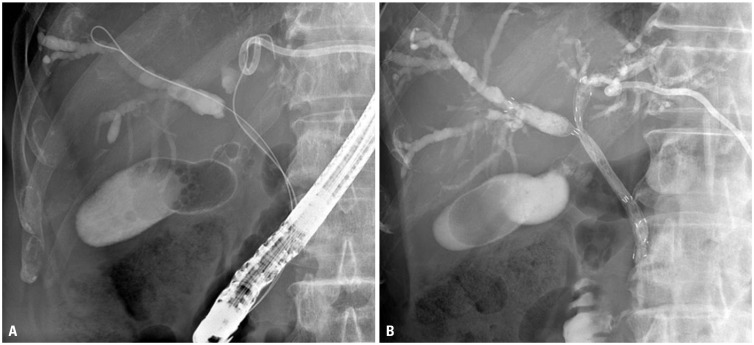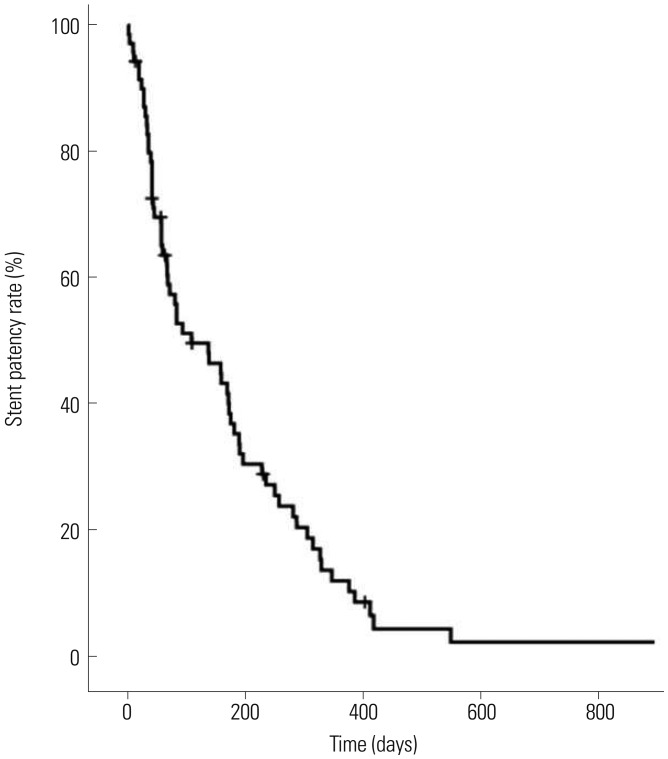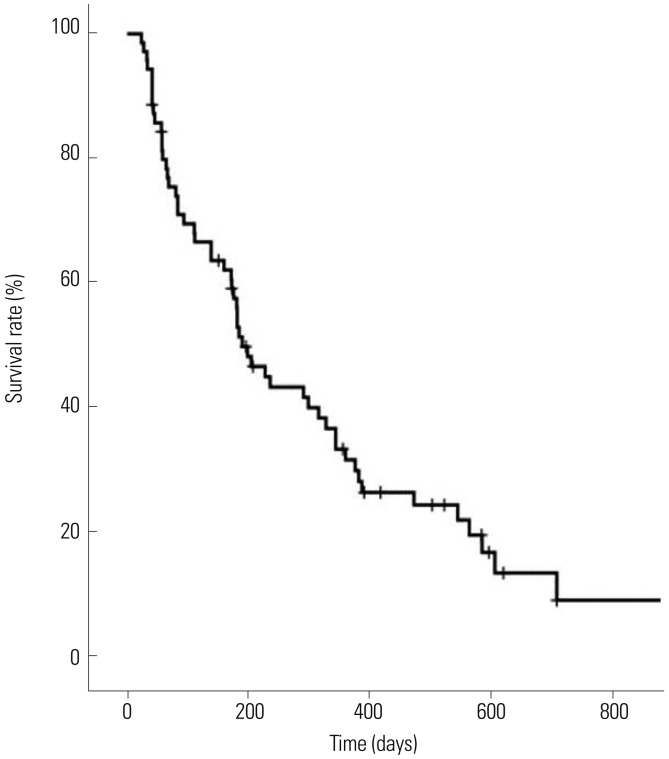Yonsei Med J.
2018 Sep;59(7):827-833. 10.3349/ymj.2018.59.7.827.
Clinical Outcomes of Bilateral Stent-in-Stent Placement Using Self-Expandable Metallic Stent for High-Grade Malignant Hilar Biliary Obstruction
- Affiliations
-
- 1Department of Internal Medicine, Institute of Gastroenterology, Yonsei University College of Medicine, Seoul, Korea. bang7028@yuhs.ac
- 2Department of Internal Medicine, Inje University Ilsan Paik Hospital, Goyang, Korea.
- 3Department of Internal Medicine and Liver Research Institute, Seoul National University Hospital, Seoul National University College of Medicine, Seoul, Korea. gidoctor@snuh.org
- KMID: 2428908
- DOI: http://doi.org/10.3349/ymj.2018.59.7.827
Abstract
- PURPOSE
Endoscopic bile duct decompression using bilateral self-expandable metallic stents (SEMSs) deployed via a stent-in-stent (SIS) method is considered a preferred procedure for malignant hilar biliary obstruction (MHBO). However, occlusion thereof occurs frequently. Here, we investigated stent patency duration and risk factors related to stent obstruction with bilateral SIS placement for MHBO at two large centers.
MATERIALS AND METHODS
The present study reviewed data on patients with MHBO who underwent endoscopic biliary drainage using the SIS method. Clinical outcomes, including stent patency duration and patient overall survival, were analyzed. Factors associated with stent patency were evaluated using Cox proportional hazards models.
RESULTS
Seventy patients with MHBO underwent endoscopic biliary drainage using the SIS method. Median age was 68 years old, and median follow-up duration was 140 days (interquartile range, 57-329). The proportion of high-grade MHBOs (Bismuth type IV) was 57.1%. Median stent patency duration with the SIS method was 108 days according to Kaplan-Meier curves. Median patient survival analyzed by the Kaplan-Meier method was 181 days. Multivariate analysis indicated that higher baseline bilirubin (> 6.1 mg/dL) as an independent risk factor related to stent patency (p < 0.05).
CONCLUSION
In endoscopic biliary decompression using SEMS placed with the SIS method, obstructive jaundice was a risk factor for stent patency. The SIS method for high-grade MHBO showed short stent patency.
Keyword
MeSH Terms
Figure
Reference
-
1. Kato H, Tsutsumi K, Kawamoto H, Okada H. Current status of endoscopic biliary drainage for unresectable malignant hilar biliary strictures. World J Gastrointest Endosc. 2015; 7:1032–1038. PMID: 26322156.
Article2. Raju RP, Jaganmohan SR, Ross WA, Davila ML, Javle M, Raju GS, et al. Optimum palliation of inoperable hilar cholangiocarcinoma: comparative assessment of the efficacy of plastic and self-expanding metal stents. Dig Dis Sci. 2011; 56:1557–1564. PMID: 21222156.
Article3. Jeong S. Basic knowledge about metal stent development. Clin Endosc. 2016; 49:108–112. PMID: 27000423.
Article4. Lee TH, Kim TH, Moon JH, Lee SH, Choi HJ, Hwangbo Y, et al. Bilateral versus unilateral placement of metal stents for inoperable high-grade malignant hilar biliary strictures: a multicenter, prospective, randomized study (with video). Gastrointest Endosc. 2017; 86:817–827. PMID: 28479493.5. Kogure H, Isayama H, Kawakubo K, Sasaki T, Yamamoto N, Hirano K, et al. Endoscopic bilateral metallic stenting for malignant hilar obstruction using newly designed stents. J Hepatobiliary Pancreat Sci. 2011; 18:653–657. PMID: 21681649.
Article6. Kogure H, Isayama H, Nakai Y, Tsujino T, Matsubara S, Yashima Y, et al. High single-session success rate of endoscopic bilateral stent-in-stent placement with modified large cell Niti-S stents for malignant hilar biliary obstruction. Dig Endosc. 2014; 26:93–99. PMID: 23517109.7. Lee TH, Lee SJ, Moon JH, Park SH. Technical tips and issues of biliary stenting, focusing on malignant hilar obstruction. Minerva Gastroenterol Dietol. 2014; 60:135–149. PMID: 24780948.
Article8. Kato H, Tsutsumi K, Harada R, Okada H, Yamamoto K. Endoscopic bilateral deployment of multiple metallic stents for malignant hilar biliary strictures. Dig Endosc. 2013; 25(Suppl 2):75–80. PMID: 23617654.
Article9. Chahal P, Baron TH. Expandable metal stents for endoscopic bilateral stent-within-stent placement for malignant hilar biliary obstruction. Gastrointest Endosc. 2010; 71:195–199. PMID: 19945101.
Article10. Kogure H, Isayama H, Nakai Y, Tsujino T, Ito Y, Yamamoto K, et al. Newly designed large cell Niti-S stent for malignant hilar biliary obstruction: a pilot study. Surg Endosc. 2011; 25:463–467. PMID: 20602139.
Article11. Hwang JC, Kim JH, Lim SG, Kim SS, Yoo BM, Cho SW. Y-shaped endoscopic bilateral metal stent placement for malignant hilar biliary obstruction: prospective long-term study. Scand J Gastroenterol. 2011; 46:326–332. PMID: 21082874.
Article12. Naitoh I, Hayashi K, Nakazawa T, Okumura F, Miyabe K, Shimizu S, et al. Side-by-side versus stent-in-stent deployment in bilateral endoscopic metal stenting for malignant hilar biliary obstruction. Dig Dis Sci. 2012; 57:3279–3285. PMID: 22732832.
Article13. Kim KM, Lee KH, Chung YH, Shin JU, Lee JK, Lee KT, et al. A comparison of bilateral stenting methods for malignant hilar biliary obstruction. Hepatogastroenterology. 2012; 59:341–346. PMID: 22353496.14. Lee TH, Moon JH, Kim JH, Park DH, Lee SS, Choi HJ, et al. Primary and revision efficacy of cross-wired metallic stents for endoscopic bilateral stent-in-stent placement in malignant hilar biliary strictures. Endoscopy. 2013; 45:106–113. PMID: 23212727.
Article15. Naitoh I, Nakazawa T, Ban T, Okumura F, Hirano A, Takada H, et al. 8-mm versus 10-mm diameter self-expandable metallic stent in bilateral endoscopic stent-in-stent deployment for malignant hilar biliary obstruction. J Hepatobiliary Pancreat Sci. 2015; 22:396–401. PMID: 25611012.
Article16. Kanno Y, Ito K, Fujita N, Noda Y, Kobayashi G, Obana T, et al. Single-session endoscopic bilateral y-configured placement of metal stents for hilar malignant biliary obstruction. Dig Endosc. 2011; 23:91–96. PMID: 21198924.
Article17. Park JM, Lee SH, Chung KH, Jang DK, Ryu JK, Kim YT, et al. Endoscopic bilateral stent-in-stent placement for malignant hilar obstruction using a large cell type stent. Hepatobiliary Pancreat Dis Int. 2016; 15:633–639. PMID: 27919853.
Article18. Moy BT, Birk JW. An update to hepatobiliary stents. J Clin Transl Hepatol. 2015; 3:67–77. PMID: 26357636.
Article19. Dumonceau JM, Tringali A, Blero D, Devière J, Laugiers R, Heresbach D, et al. Biliary stenting: indications, choice of stents and results: European Society of Gastrointestinal Endoscopy (ESGE) clinical guideline. Endoscopy. 2012; 44:277–298. PMID: 22297801.
Article20. Miura S, Kanno A, Masamune A, Hamada S, Takikawa T, Nakano E, et al. Bismuth classification is associated with the requirement for multiple biliary drainage in preoperative patients with malignant perihilar biliary stricture. Surg Endosc. 2015; 29:1862–1870. PMID: 25277483.
Article21. Miura S, Kanno A, Masamune A, Hamada S, Hongou S, Yoshida N, et al. Risk factors for recurrent biliary obstruction following placement of self-expandable metallic stents in patients with malignant perihilar biliary stricture. Endoscopy. 2016; 48:536–545. PMID: 26987646.
Article22. Patel T. Cholangiocarcinoma--controversies and challenges. Nat Rev Gastroenterol Hepatol. 2011; 8:189–200. PMID: 21460876.
Article23. Anderson CD, Pinson CW, Berlin J, Chari RS. Diagnosis and treatment of cholangiocarcinoma. Oncologist. 2004; 9:43–57.
Article24. Lee JM, Lee SH, Chung KH, Park JM, Paik WH, Woo SM, et al. Small cell- versus large cell-sized metal stent in endoscopic bilateral stent-in-stent placement for malignant hilar biliary obstruction. Dig Endosc. 2015; 27:692–699. PMID: 25708157.
Article25. Lee JM, Lee SH, Jang DK, Chung KH, Park JM, Paik WH, et al. Air cholangiography in endoscopic bilateral stent-in-stent placement of metallic stents for malignant hilar biliary obstruction. Therap Adv Gastroenterol. 2016; 9:189–198.
Article26. Kawakami H, Itoi T, Kuwatani M, Kawakubo K, Kubota Y, Sakamoto N. Technical tips and troubleshooting of endoscopic biliary drainage for unresectable malignant hilar biliary obstruction. J Hepatobiliary Pancreat Sci. 2015; 22:E12–E21. PMID: 25379788.
Article27. Isayama H, Nakai Y, Toyokawa Y, Togawa O, Gon C, Ito Y, et al. Measurement of radial and axial forces of biliary self-expandable metallic stents. Gastrointest Endosc. 2009; 70:37–44. PMID: 19249766.
Article28. Isayama H, Nakai Y, Hamada T, Matsubara S, Kogure H, Koike K. Understanding the mechanical forces of self-expandable metal stents in the biliary ducts. Curr Gastroenterol Rep. 2016; 18:64. PMID: 27778304.
Article29. Kim DU, Kang DH, Kim GH, Song GA, Kim CW, Kim S, et al. Bilateral biliary drainage for malignant hilar obstruction using the ‘stent-in-stent’ method with a Y-stent: efficacy and complications. Eur J Gastroenterol Hepatol. 2013; 25:99–106. PMID: 23022984.
- Full Text Links
- Actions
-
Cited
- CITED
-
- Close
- Share
- Similar articles
-
- Which is better for unresectable malignant hilar biliary obstruction: Side-by-side versus stent-in-stent?
- Endoscopic Stent Placement in the Palliation of Malignant Biliary Obstruction
- Endoscopic Reintervention for Recurrence of Malignant Biliary Obstruction: Developing the Best Strategy
- Combined Treatment with Metallic Stent Placement and Radiotherapy in Malignant Biliary Obstruction
- Current Status of Biliary Metal Stents




